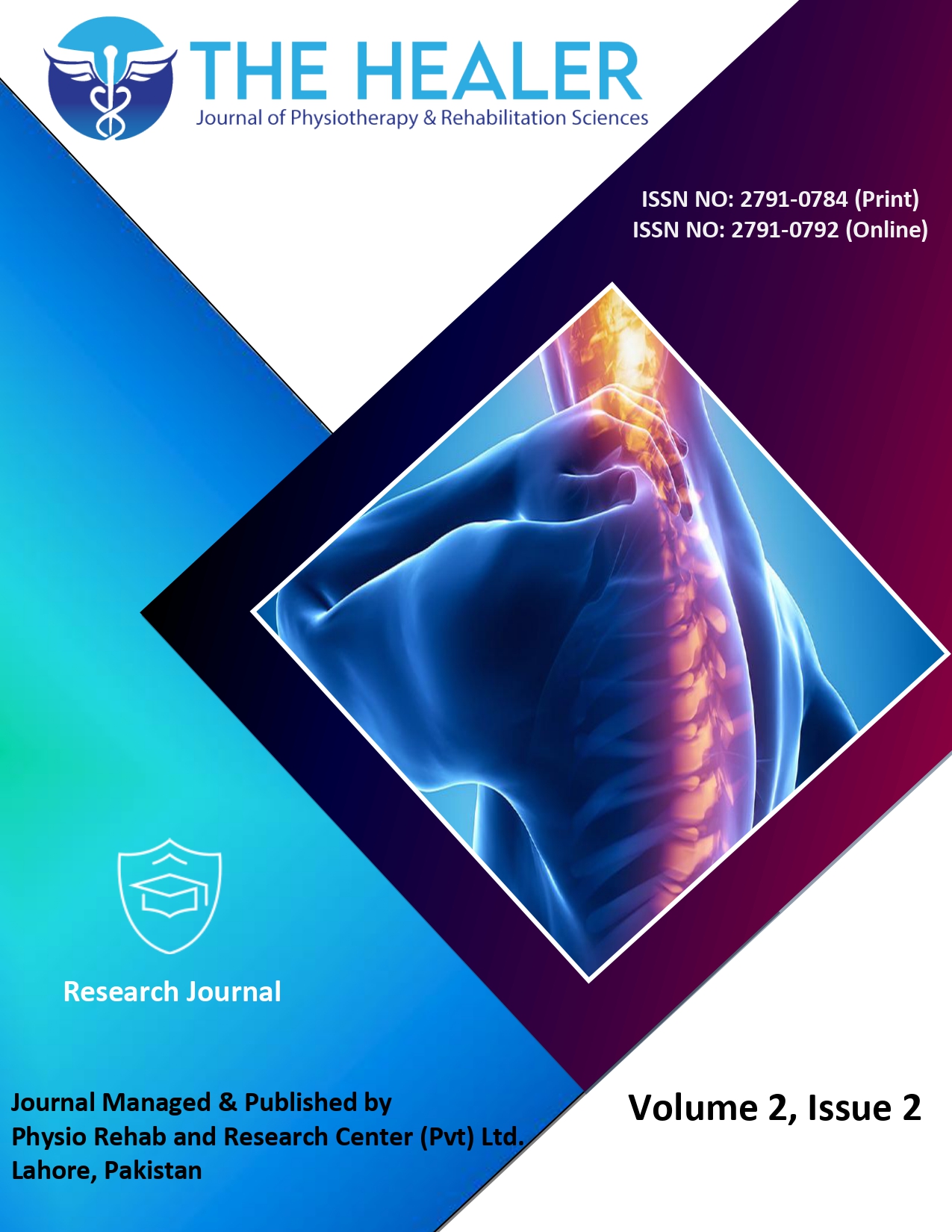Factors Leading to Cervical Pain among Display Screen Equipment Operators; An Observational Study
Factors Leading to Cervical Pain
DOI:
https://doi.org/10.55735/hjprs.v2i2.77Keywords:
cervical pain, risk factors, video display terminal, computer operatorsAbstract
Background: Computer operators are more to develop pain in the cervical region. With a wide range of possible risk factors, that vary from person to person, this area requires continuous investigation. So that workplace can be modified to promote work safety. Objective: To estimate the association of different risk factors of neck pain among display screen equipment users in office settings. Methods: Using display screen equipment self-assessment questionnaire and musculoskeletal discomfort form, the data was gathered from offices in different cities of Pakistan. Office workers under 60 years who used a display screen for more than an hour each day were eligible to participate in the study. While those having any history of spinal deformities, cervical surgery, trauma or malignancy was excluded. For statistical computation and analysis, the data from 122 participants were recorded in SPSS version 21. The prevalence of neck pain and frequency distribution of variables were computed. The chi-square test was used to determine the correlation between the variables, and the p-value less than or equal to 0.05 were considered significant. Results: Neck pain was seen in 41.8% out of the 122 study participants. It was observed to affect the daily activities of 29.4% of the population, while 62.7% had experienced discomfort in the previous week. Neck pain was found to be substantially correlated with work fulfillment, stress and male gender. While among ergonomic factors it was linked to breaks from work, the height of the screen used, and computer hardware adjustability. Conclusion: Many office workers using display screen equipment report cervical pain. It is associated with both workplace and individual-level factors and such problems can be avoided by enhancing workplace ergonomics.
References
Nakazawa T, Okubo Y, Suwazono Y, Kobayashi E, Komine S, Kato N, et al. Association between duration of daily VDT use and subjective symptoms. Am J Ind Med. 2002 Nov 1 [cited 2022 Sep 14];42(5):421–6. Available from: https://onlinelibrary.wiley.com/doi/full/10.1002/ajim.10133
Janwantanakul P, Pensri P, Jiamjarasrangsri V, Sinsongsook T. Prevalence of self-reported musculoskeletal symptoms among office workers. Occup Med (Chic Ill). 2008 [cited 2022 Sep 14];58(6):436–8. Available from: https://www.researchgate.net/publication/5311876_Prevalence_of_self-reported_musculoskeletal_symptoms_among_office_workers
Carter JB, Banister EW. Musculoskeletal problems in VDT work: a review. http://dx.doi.org/101080/00140139408964941 [Internet]. 2007 [cited 2022 Sep 14];37(10):1623–48. Available from: https://www.tandfonline.com/doi/abs/10.1080/00140139408964941
Paksaichol A, Lawsirirat C, Janwantanakul P. Contribution of biopsychosocial risk factors to nonspecific neck pain in office workers: A path analysis model. J Occup Health [Internet]. 2015 [cited 2022 Sep 13];57(2):100–9. https://pubmed.ncbi.nlm.nih.gov/25476863/
Robertson MM, O’Neill MJ. Reducing musculoskeletal discomfort: Effects of an office ergonomics workplace and training intervention. Int J Occup Saf Ergon. 2003;9(4):491–502.
Ahmed I, Shaukat MZ. Computer users’ ergonomics and quality of life - evidence from a developing country. Int J Inj Contr Saf Promot [Internet]. 2018 Apr 3 [cited 2022 Sep 14];25(2):154–61. Available from: https://pubmed.ncbi.nlm.nih.gov/29280402/
Kuorinka I, Jonsson B, Kilbom A, Vinterberg H, Biering-Sørensen F, Andersson G, et al. Standardised Nordic questionnaires for the analysis of musculoskeletal symptoms. Appl Ergon. 1987 Sep 1;18(3):233–7.
Hogg-Johnson S, Van Der Velde G, Carroll LJ, Holm LW, Cassidy JD, Guzman J, et al. The burden and determinants of neck pain in the general population: Results of the Bone and Joint Decade 2000-2010 Task Force on Neck Pain and Its Associated Disorders. Spine (Phila Pa 1976) [Internet]. 2008 Feb [cited 2022 Sep 14];33(4 SUPPL.). Available from: https://journals.lww.com/spinejournal/Fulltext/2008/02151/The_Burden_and_Determinants_of_Neck_Pain_in_the.9.aspx
Nilsen TIL, Holtermann A, Mork PJ. Physical exercise, body mass index, and risk of chronic pain in the low back and neck/shoulders: longitudinal data from the Nord-Trondelag Health Study. Am J Epidemiol [Internet]. 2011 Aug 1 [cited 2022 Sep 14];174(3):267–73. Available from: https://pubmed.ncbi.nlm.nih.gov/21633119/
Palmer KT, Syddall H, Cooper C, Coggon D. Smoking and musculoskeletal disorders: findings from a British national survey. Ann Rheum Dis [Internet]. 2003 Jan 1 [cited 2022 Sep 14];62(1):33. Available from: /pmc/articles/PMC1754283/?report=abstract
Ariëns GAM, Van Mechelen W, Bongers PM, Bouter LM, Van Der Wal G. Physical risk factors for neck pain. Scand J Work Environ Health [Internet]. 2000 [cited 2022 Sep 14];26(1):7–19. Available from: https://pubmed.ncbi.nlm.nih.gov/10744172/
Ortiz-Hernández L, Tamez-González S, Martínez-Alcántara S, Méndez-Ramírez I. Computer use increases the risk of musculoskeletal disorders among newspaper office workers. Arch Med Res [Internet]. 2003 Apr 21 [cited 2022 Sep 14];34(4):331–42. Available from: https://eurekamag.com/research/048/618/048618519.php
Reinert F, Caselli RP, Moro ARP, Gontijo LA, Ferreira MGG. Human factors related to the use of a personal computer: A case study. Work. 2020 Jan 1;65(1):225–30.
Yu ITS, Wong TW. Musculoskeletal problems among VDU workers in a Hong Kong bank. Occup Med (Lond) [Internet]. 1996 [cited 2022 Sep 14];46(4):275–80. Available from: https://pubmed.ncbi.nlm.nih.gov/8854704/
Eltayeb S, Staal JB, Hassan A, De Bie RA. Work related risk factors for neck, shoulder and arms complaints: a cohort study among Dutch computer office workers. J Occup Rehabil [Internet]. 2009 Dec [cited 2022 Sep 14];19(4):315–22. Available from: https://pubmed.ncbi.nlm.nih.gov/19685174/
Gerr F, Marcus M, Monteilh C. Epidemiology of musculoskeletal disorders among computer users: lesson learned from the role of posture and keyboard use. J Electromyogr Kinesiol. 2004 Feb 1;14(1):25–31.
Shikdar AA, Al-Kindi MA. Office ergonomics: deficiencies in computer workstation design. Int J Occup Saf Ergon [Internet]. 2007 [cited 2022 Sep 14];13(2):215–23. Available from: https://pubmed.ncbi.nlm.nih.gov/17599795/

Downloads
Published
How to Cite
License
Copyright (c) 2022 The Healer Journal of Physiotherapy and Rehabilitation Sciences

This work is licensed under a Creative Commons Attribution 4.0 International License.










